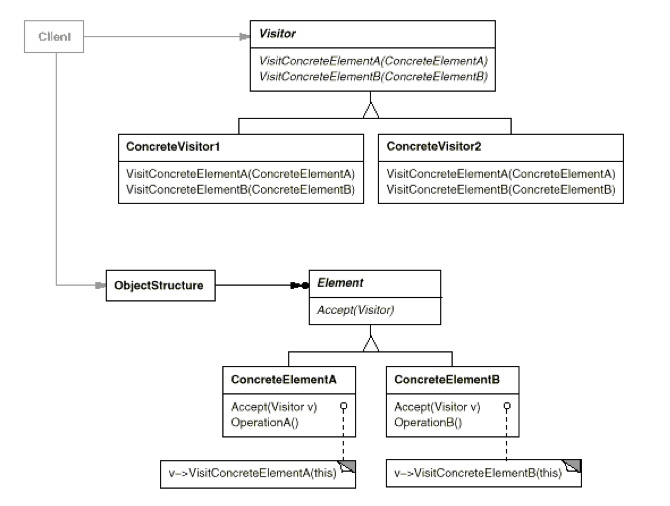|
The Visitor Pattern is a behavioral design pattern that allows you to define a new operation to be applied to different classes of elements (also known as Visitable classes) without modifying those element classes directly. This pattern groups the same new operation together using a Visitor class, which contains separate member functions for each kind of Element/Visitable class. overviewVisitor pattern lets you add a new operation to a structure of objects (Visitable/Elements) to be traversed through, without changing the Visitable/Element on which it operates. Visitor class separates would-be virtual functions of the Visitable/Element class into a Visitor class. Each Visitable/Element should implement an accept(Visitor) function which delegates the request to the underlying Visitor class via calling visitor.visit(this) from accept(Visitor). Each concrete Visitor class implements a set of visit(Object) functions that does the real work for the operation to be applied to the structure of objects. Each visit(Object) function takes in a different type of concrete Visitable/Element object. The Visitor can optionally maintain a context during a traversal.  source: GoF Notes:
scenarioConsider a compiler program that deals with an abstract syntax tree. Each node in the abstract syntax tree may be a variable, an assignment, arithmetic expression, etc. For each node element, you want to apply operations like type-checking, code optimization, pretty-formatting, etc. One way of structuring the above is to have a node class hierarchy. Within node class hierarchy, for each different node class, you define its type-checking operation, code optimization operation, and pretty-formatting operation inside the node class. This has three potential drawbacks:
To avoid the above drawbacks, apply the Visitor pattern which defines two class hierarchies: one (the visitable Element hierarchy) for the nodes or data structure being operated on and one (the Visitor hierarchy) for defining operations to be applied to the elements. The delegation of the operation from an element class to a visitor class is through an accept(Visitor) function defined in the element class. Then in terms, calls into Visitor.visit(this). When you need to introduce a new type of operation, you'd create a new subclass in the Visitor hierarchy, without needing to modify the Element hierarchy. visitor pattern code sampleThe element/visitable interface simply defines an accept method to allow the visitor to run some action over that element - the ConcreteElement will implement this accept method. // Element Interface [1] Delegate operation applied to an element to a corresponding visitor class. [2] Visitor class holds local state. In this case, to accumulate postage cost. [3] Request the result of the operation/computation/local state. comparisonVisitors over Getters? I have reservations about embracing the concept of Visitors over Getters. In most cases, using Visitors might be excessive when a simpler approach, such as method overriding with virtual function, would suffice. Visitor Pattern vs. Non-Visitor Pattern
when to use visitor patternChoose to use Visitor pattern if:
references
0 Comments
Leave a Reply. |
Categories
All
Archives
May 2020
|
 RSS Feed
RSS Feed